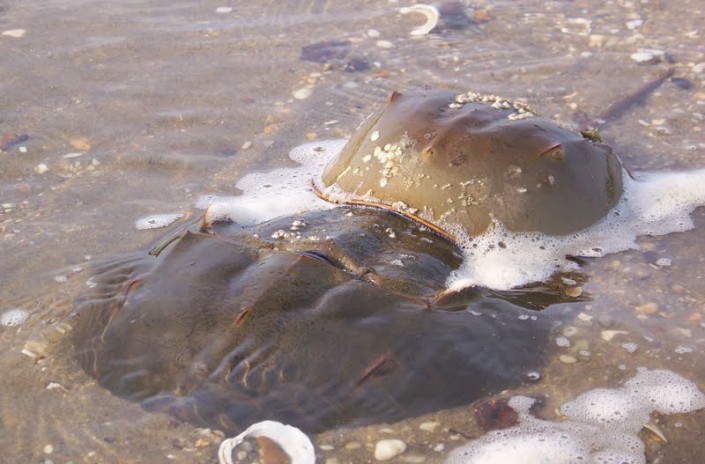Horseshoe Crab Tagging and Monitoring in Raritan/Sandy Hook Bay
Bayshore Regional Watershed Council Looking for Volunteers to Help Out Four Nights in May and June
By: Lindsay McNamara, Communications Coordinator

The Bayshore Regional Watershed Council (BRWC) is looking for volunteers to help monitor and tag horseshoe crabs in Sandy Hook and Raritan Bay this May and June. Since 2009, BRWC has been collecting hard data through their volunteer-driven monitoring and tagging program. This data is used to help analyze the population of horseshoe crabs in the region and better inform conservation efforts to protect them.
Lately on the Bayshore, the Council has seen a ratio of about 35 males per 1 female, which is a cause for concern. Why are there so few females? How will the population continue to survive in the region with such a low number of mature, female horseshoe crabs?
BRWC investigated the issue and found that New York State is harvesting about 100,000 horseshoe crabs a year from the Harbor. Female horseshoe crabs are frequently harvested because their eggs are used as bait for fishermen. Horseshoe crab numbers have dropped dramatically in New York area waters, BRWC thinks in part because of the harvest. According to the Council’s website, over the last 150 years, horseshoe crab populations have declined 90%. What can concerned citizens do to help protect the current population of horseshoe crabs in Sandy Hook/Raritan Bay from further decline?
Volunteering with Bayshore Regional Watershed Council is a great place to start. Volunteers monitor and tag horseshoe crabs on four nights (alligned with the new and full moon and the tides) through May and June on Sandy Hook/Raritan Bay. The volunteers record clusters, single females, single males, swimming pairs, and other data points on tally sheets at five different locations on the Bayshore. The recordings function as a sampling of the population; volunteers monitor an area of 1,000 feet by 6 feet on the beach. BRWC volunteers can see anywhere from 10-125 horseshoe crabs a night, depending on the site.
Adult horseshoe crabs are also tagged. The tag displays a New Jersey Division of Fish and Wildlife phone number that can be called if the horseshoe crab is seen again. These tags and calls by the general public help biologists to better understand horseshoe crab behavior and where they go when they are not spawning. BRWC suspects that older horseshoe crabs return to the ocean out past the continental shelf, while younger horseshoe crabs stay in the bay. Volunteering will help the Council collect more data to analyze these observations and trends.
Take action to help protect these over 250 million year old creatures:
Bayshore Regional Watershed Council is recruiting volunteers at:
- Cliffwood Beach in Aberdeen Township
- Conaskonck Point in Union Beach
- Leonardo Public Beach in Middletown Township
- The mouth of Many Mind Creek in Atlantic Highlands
- Plum Island at Sandy Hook National Recreation Area
Dates and times for the 2015 monitoring program are:
- Monday, May 4, 2015 at 8:30pm
- Monday, May 18, 2015 at 8:30pm
- Tuesday, June 2, 2015 at 8:30pm
- Tuesday, June 16, 2015 at 8:30pm
For more information, visit Bayshore Regional Watershed Council’s website.
Lindsay McNamara is the Communications Coordinator for Conserve Wildlife Foundation of New Jersey.